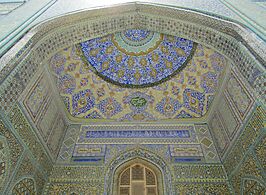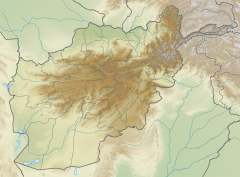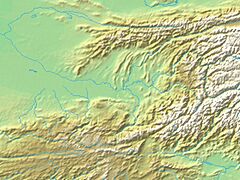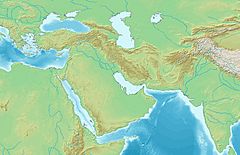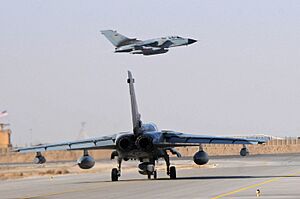Mazar-i-Sharif facts for kids
Quick facts for kids
Mazar-i-Sharīf
|
|
|---|---|
| مزار شریف | |
| Country | |
| Province | Balkh |
| District | Nahri Shahi |
| Area | |
| • Land | 83 km2 (32 sq mi) |
| Elevation | 357 m (1,171 ft) |
| Population | |
| • Estimate
(2021)
|
500,207 |
| Time zone | UTC+4:30 (Afghanistan Standard Time) |
| Climate | BSk |
Mazar-i-Sharif (also called Mazar-e Sharif or just Mazar) is a large city in Afghanistan. It is the fourth-largest city in the country. In 2021, about 500,207 people lived there.
Mazar-i-Sharif is the capital of Balkh Province. It is connected by major roads to other cities like Kunduz, Kabul, and Herat. The city is also close to the border with Uzbekistan, about 55 kilometers (34 miles) away.
This city is a popular place for tourists. People visit to see its famous shrines and ancient sites. These sites show Islamic and Hellenistic history. The very old city of Balkh is also nearby.
For many centuries, the area around Mazar-i-Sharif was part of a larger region called Greater Khorasan. Different empires and kingdoms ruled it, including the Tahirids, Samanids, and Timurids. In 1751, it became part of the Durrani Empire. Later, in 1849, it officially became part of Afghanistan.
Mazar-i-Sharif is an important center for northern Afghanistan. It is close to both Uzbekistan and Tajikistan. The city also has an international airport. It is the lowest major city in Afghanistan, sitting about 357 meters (1,171 feet) above sea level. Unlike other big cities in Afghanistan, Mazar-i-Sharif was mostly safe during the Soviet–Afghan War and later civil war. It was known as one of the safest cities in the country for a long time.
However, on August 14, 2021, Taliban fighters took control of Mazar-i-Sharif. This was part of their larger 2021 Taliban offensive across Afghanistan.
Contents
What Does the Name Mean?
The name Mazar-i-Sharif means "tomb of the saint." This name refers to the tomb of Ali. Ali was a cousin, son-in-law, and friend of the Islamic prophet Muhammad.
The tomb is inside a large, blue-tiled building in the city center. This building is a mosque and sanctuary known as the Shrine of Ali or the Blue Mosque.
A Look at History
Early Times
The Achaemenid Empire ruled this region starting in the 6th century BCE. Later, Alexander the Great conquered the area. After he died, it became part of the Seleucid Empire.
When the Seleucid Empire weakened, the Greco-Bactrian Kingdom appeared. Around 130 BCE, the Saka people took over, and the Greco-Bactrian kingdom fell. Then, the Yuezhi people took control, which led to the creation of the Kushan Empire. After the Kushans, the Sasanian Empire ruled the area. Finally, Islamic armies arrived in Mazar-i-Sharif in 651 CE.
From the 800s to the Early 1900s
The region around Mazar-i-Sharif was part of Greater Khorasan for many centuries. It was ruled by several powerful groups. These included the Tahirids, Saffarids, Samanids, Ghaznavids, Ghurids, Ilkhanids, Timurids, and the Khanate of Bukhara.
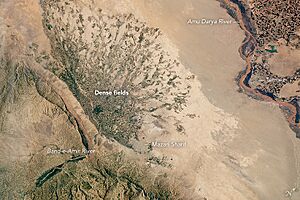
The famous poet Jalal al-Din Rumi was born somewhere in this area.
A Seljuk ruler named Ahmed Sanjar ordered a city and shrine to be built here. However, Genghis Khan and his Mongol army destroyed it in the 13th century. The city was later rebuilt.
In the 1800s, the area had problems with drainage. This caused floods and a disease called malaria. Because of this, the local ruler decided to move the capital to Mazar-i-Sharif.
Around 1751, the city became part of the Durrani Empire. However, local Uzbek rulers often had control. In 1849, Mazar-i-Sharif was fully taken over and became part of Afghanistan.
Late 20th Century Events
During the Soviet–Afghan War in the 1980s, Mazar-i-Sharif was an important base for the Soviet Army. They used its airport to launch attacks against rebel fighters called mujahideen. The city was also a key link to Soviet territory in the north.
The city was controlled by General Abdul Rashid Dostum and his army. In 1992, Dostum rebelled against the government and took over the city. Mazar-i-Sharif then became a relatively stable and peaceful place in northern Afghanistan under Dostum's rule. It was seen as a "glittering jewel" compared to other war-torn cities. Money came from countries like Russia and Turkey. The city was more open, with coeducational schools and legal betting, unlike areas controlled by the Taliban.
This peace ended in May 1997. One of Dostum's generals, Abdul Malik Pahlawan, joined forces with the Taliban. Dostum had to leave Mazar-i-Sharif. However, Pahlawan then turned against the Taliban. Many Taliban members were reportedly killed during this time. Dostum later returned and took the city back from Pahlawan.
But in 1998, the Taliban attacked the city again. During the attack, many people who were not fighting were killed.
Since 2001
After the September 11 attacks in 2001, Mazar-i-Sharif was the first Afghan city to be taken by the Northern Alliance. This group was supported by the United States. The Taliban's defeat in Mazar-i-Sharif led to their quick retreat from other parts of northern and western Afghanistan.
Following the Battle of Mazar-i-Sharif in November 2001, the Northern Alliance officially captured the city. They were helped by United States Special Operations Forces and U.S. Air Force planes. There were reports that many Taliban fighters who surrendered were killed after the battle.
After 2002, the city slowly came under the control of the Afghan government led by President Hamid Karzai. The 209th Corps of the Afghan National Army is based in Mazar-i-Sharif. This group helps with military support in northern Afghanistan. The headquarters for the Afghan Border Police in the Northern Zone is also in the city.
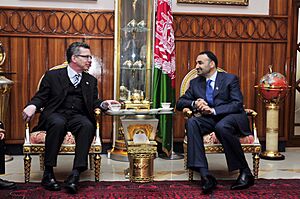
Small fights between different groups continued in 2002. The United Nations worked to help solve these issues and collect small weapons. In 2003, an office for human rights opened in Mazar-i-Sharif. There were also reports of some ethnic groups being forced out of their homes.
NATO-led peacekeeping forces helped the Afghan government in the city. ISAF Regional Command North, led by Germany, was based at Camp Marmal near the airport. Soldiers from Sweden, Latvia, and Norway also helped.
In 2006, new ancient Greek remains were found in the area.
On August 11, 2021, President Ghani visited the city to encourage local leaders to fight the Taliban. However, on August 14, the Taliban captured Mazar-i-Sharif. Local government forces and leaders like Abdul Rashid Dostum and Atta Mohammad Noor fled to Uzbekistan.
Mazar-i-Sharif is also famous for the Afghan song Bia ke berem ba Mazar (Come let's go to Mazar) by Sarban.
Geography and Weather
Climate
Mazar-i-Sharif has a cold steppe climate. This means it has very hot summers and cold winters. Not much rain falls, mostly between December and April.
In summer, from June to August, daily temperatures can go above 40°C (104°F). Winters are cold, with temperatures often below freezing. It can snow from November to March.
| Climate data for Mazar-i-Sharif | |||||||||||||
|---|---|---|---|---|---|---|---|---|---|---|---|---|---|
| Month | Jan | Feb | Mar | Apr | May | Jun | Jul | Aug | Sep | Oct | Nov | Dec | Year |
| Record high °C (°F) | 24.0 (75.2) |
28.6 (83.5) |
32.4 (90.3) |
37.8 (100.0) |
43.0 (109.4) |
45.6 (114.1) |
48.1 (118.6) |
46.0 (114.8) |
39.5 (103.1) |
37.0 (98.6) |
29.8 (85.6) |
24.4 (75.9) |
48.1 (118.6) |
| Mean daily maximum °C (°F) | 8.0 (46.4) |
10.7 (51.3) |
16.3 (61.3) |
24.3 (75.7) |
31.2 (88.2) |
37.0 (98.6) |
38.9 (102.0) |
36.9 (98.4) |
31.9 (89.4) |
24.7 (76.5) |
16.4 (61.5) |
10.8 (51.4) |
23.9 (75.1) |
| Daily mean °C (°F) | 2.6 (36.7) |
5.1 (41.2) |
10.8 (51.4) |
17.9 (64.2) |
24.5 (76.1) |
29.9 (85.8) |
33.3 (91.9) |
29.9 (85.8) |
23.9 (75.0) |
16.7 (62.1) |
9.1 (48.4) |
5.1 (41.2) |
17.4 (63.3) |
| Mean daily minimum °C (°F) | −2.1 (28.2) |
0.0 (32.0) |
5.1 (41.2) |
11.3 (52.3) |
16.6 (61.9) |
22.5 (72.5) |
25.9 (78.6) |
23.8 (74.8) |
17.1 (62.8) |
9.4 (48.9) |
3.2 (37.8) |
0.0 (32.0) |
11.1 (51.9) |
| Record low °C (°F) | −22.3 (−8.1) |
−24.0 (−11.2) |
−6.1 (21.0) |
−0.8 (30.6) |
1.0 (33.8) |
11.4 (52.5) |
11.1 (52.0) |
13.7 (56.7) |
2.6 (36.7) |
4.5 (40.1) |
−8.7 (16.3) |
−15.5 (4.1) |
−24.0 (−11.2) |
| Average precipitation mm (inches) | 28.9 (1.14) |
34.8 (1.37) |
43.8 (1.72) |
28.3 (1.11) |
11.2 (0.44) |
0.2 (0.01) |
0.0 (0.0) |
0.0 (0.0) |
0.1 (0.00) |
3.9 (0.15) |
13.5 (0.53) |
21.7 (0.85) |
186.4 (7.32) |
| Average rainy days | 4 | 7 | 10 | 9 | 4 | 0 | 0 | 0 | 0 | 2 | 4 | 6 | 46 |
| Average snowy days | 4 | 3 | 1 | 0 | 0 | 0 | 0 | 0 | 0 | 0 | 0 | 2 | 10 |
| Average relative humidity (%) | 79 | 77 | 72 | 64 | 44 | 27 | 25 | 24 | 28 | 41 | 62 | 75 | 52 |
| Mean monthly sunshine hours | 122.2 | 118.4 | 158.1 | 193.8 | 299.9 | 352.9 | 364.4 | 332.7 | 298.2 | 223.2 | 173.6 | 125.5 | 2,762.9 |
| Source: NOAA (1959–1983) | |||||||||||||
People of Mazar-i-Sharif

Mazar-i-Sharif has a population of 500,207 people. It is the fourth-largest city in Afghanistan. The city covers an area of 8,304 hectares (about 20,520 acres). There are 77,615 homes in the city.
The people living in Mazar-i-Sharif come from different ethnic groups. In 2003, a magazine reported that the population included:
The main language spoken in Mazar-i-Sharif is Persian. Other languages like Pashto and Uzbek are also spoken.
City Economy
Mazar-i-Sharif is a major center for trade in northern Afghanistan. The city's economy mainly relies on:
- Trade
- Agriculture (farming)
- Karakul sheep farming (raising sheep for their wool and skins)
There is also some small-scale oil and gas production. This helps the city's economy grow. Countries like India and Pakistan have consulates here. These offices help with trade and political connections.
Places to See
The modern city of Mazar-i-Sharif is built around the Shrine of Ali. This shrine has been restored many times and is one of Afghanistan's most beautiful buildings.
Outside the city is the ancient city of Balkh. Mazar-i-Sharif is also a center for the traditional sport of buzkashi. The Blue Mosque is a key place for the Nowruz celebration in northern Afghanistan.
Most Muslims believe that the real grave of Ali is in Najaf, Iraq. However, many people still visit Mazar-i-Sharif to show their respect.

Here are some important places in Mazar-i-Sharif:
- Airports
- Mazar-i-Sharif Airport – This airport serves the people of Balkh Province. It is also used by NATO-led forces and the Afghan Air Force. It is being expanded to become the fourth international airport in Afghanistan.
- Mosques
- Shrine of Ali (also known as the Blue Mosque)
- Parks and Monuments
- Park-e-Ariana
- Maulana Jalaludin Cultural Park
- Tashkurgan Palace
- Governors Palace
- Mazar-i-Sharif Gate
- Khalid Ibn-al Walid Park
- Universities
- Balkh University
- Aria University
- Sadat University
- Mawlana University
- Taj University
- Turkistan University
- Rah-e-Saadat University
Sports in the City
Mazar-i-Sharif has several professional sports teams:
| Club | League | Sport | Venue | Established |
|---|---|---|---|---|
| Balkh Legends | Afghanistan Premier League | Cricket | Sharjah Cricket Stadium | 2018 |
| Amo Sharks | Shpageeza Cricket League | Cricket | Balkh Cricket Stadium | 2013 |
| Simorgh Alborz F.C. | Afghan Premier League | Football | Balkh Ground | 2012 |
- Stadiums
- Balkh Cricket Stadium
- Buzkashi Stadium
Getting Around
Transportation
Rail
Mazar-i-Sharif was the first city in Afghanistan to have a railway connection to a neighboring country. Train service to Uzbekistan started in December 2011. Cargo trains arrive at a station near Mazar-i-Sharif Airport. Goods are then moved to trucks or airplanes to reach their final destinations across Afghanistan.
Air
As of June 2016, Mazar-i-Sharif Airport has direct flights to:
Road
Highway AH76 connects Mazar-i-Sharif to:
- Sheberghan in the west
- Pul-e Khomri and Kabul to the southeast
- Kunduz to the east
Roads to the north connect it to the Uzbek border town of Termez. From there, highway M39 goes north to Samarkand and Tashkent. Roads to the south lead to Bamiyan Province and the mountains of central Afghanistan.
Famous People from Mazar-i-Sharif
- Emir Wazir Akbar Khan (buried in the city)
- Emir Sher Ali Khan (buried in the city)
- Ajab Khan Afridi (freedom fighter against British rule)
- Zalmay Khalilzad (Afghan-born American diplomat)
- Wasef Bakhtari (Afghan poet and writer, grew up in Mazar-i-Sharif)
- Abdul Ali Mazari (Hazara political leader, born near Mazar-i-Sharif)
- Muhammad Mohaqiq (Afghan politician)
- Atta Muhammad Nur (former commander and Governor of Balkh Province, born in Mazar-i-Sharif)
- Farshad Noor (Afghan professional football player)
Sister Cities
Mazar-i-Sharif has "sister city" relationships with:
See also
 In Spanish: Mazar-e Sarif para niños
In Spanish: Mazar-e Sarif para niños







